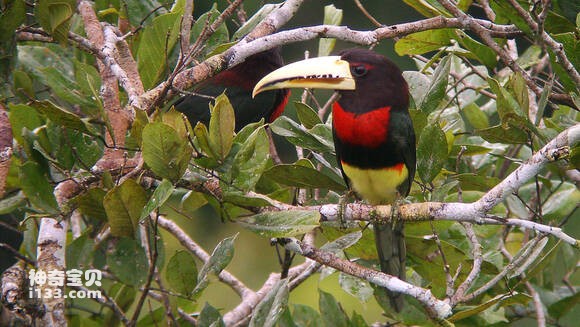Pteroglossus azara
IUCN
LCBasic Information
Scientific classification
- name:Pteroglossus azara
- Scientific Name:Pteroglossus azara,Ivory-billed aracari
- Outline:Climbing birds
- Family:
Vital signs
- length:No textual research information is available
- Weight:No textual research information is available
- lifetime:No textual research information is available
Feature
Distribution and Habitat
It is found in South America (Colombia, Venezuela, Guyana, Suriname, Ecuador, Peru, Bolivia, Paraguay, Brazil, Chile, Argentina, Uruguay, and the Malvinas Islands (also known as the Falkland Islands).
The white-billed Tufted Toucan inhabits warm forests and marginal areas, preferring treetops.
Appearance
The white-billed tufted toucan looks a little like a hornbill. The upper body is chestnut, the wings are black, the chest is bright red, the waist is black, and the head is usually black and chestnut. The lower abdomen is predominantly yellow with one or more black or red markings. Long beak white. The margin of the beak is usually clearly serrated, black or ivory in appearance, and looks somewhat like a tooth. Despite its large beak, the Toucan weighs less than 30 grams. The structure of the mouth bone is very special, it is not a dense entity, the outside is a layer of crust, through the middle of extremely fine fibers, porous spongy tissue, filled with air, so that it does not feel heavy pressure.
Details
The species has two subspecies, Pteroglossus azara and Ivory-billed aracari.

The white-billed tufted toucan is also the noisiest of the forest birds, producing loud rumbles, trumpets, and screeches. Its nest is built in a hole high in a tree. When eating, always peck the food with the tip of the mouth first, then tilt the neck, throw the food upward, and then open the big mouth to accurately put the food into the throat, without having to go through the long mouth and spend time in the process of "swallowing". The Tufted Toucan is omnivorous and feeds on fruits, seeds, and insects.

The white-billed tugs nest in tree cavities and sometimes raid the nests of young birds, eating eggs and chicks. - Lay 2 to 4 eggs. The smooth white eggs are piled in unlined holes and hatch in about 16 days. The chicks that hatch are completely naked, take at least three weeks to open their eyes, and begin to live their own lives about 45 days after hatching.
Protect wild animals and eliminate wild meat.
Maintaining ecological balance is everyone's responsibility!








